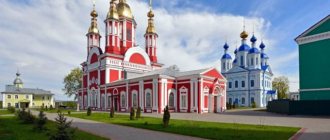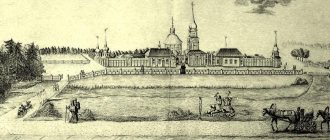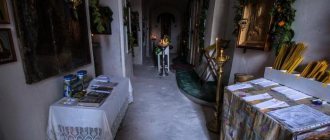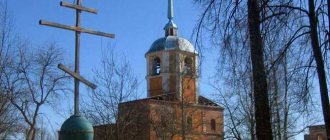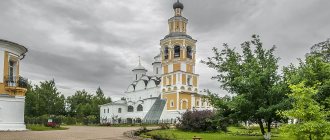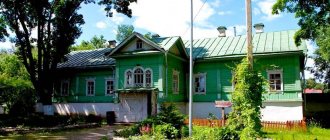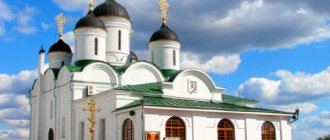Delicious chak-chak, mysterious ochpochmaki, Shalyapin and Tolstoy streets, the recreated Kul Sharif mosque - all this is attractive to tourists in Kazan and valuable to the residents themselves. But there are deeper and more important sights of the capital of Tatarstan. We are talking about an extraordinary place with an extraordinary history - the Kazan Bogoroditsky Monastery.
In the history of his native city, he is about 6 centuries old - and all these years he experienced terrible fires, sunrises and sunsets, attacks by Pugachev, hunger and cold, joy and peace together with the people of Kazan. Nowadays, fortunately, the people's trail of pilgrims is not overgrown - Orthodox Christians and others from all over the world are rushing to pray at the miraculous image of the Kazan Icon of the Mother of God. I usually begin all the stories about this place for family and friends with her appearance.
History of the monastery
How it all began
I close my eyes, try to disconnect from the hustle and bustle around me and imagine the events of days gone by. The year is 1579, a hot, very hot summer. There was a big fire in Kazan; almost a third of the buildings in the capital of the Tatar region burned down. Among the fire victims is the family of a Streltsy centurion named Danila Onuchin. He had a daughter, Matrona (12 years old). In a dream, the Virgin Mary appeared to the girl three times and ordered her to go to that same ashes in the northeast and find the Image there. Matrona’s mother conveyed the vision to Archbishop Jeremiah, and he blessed the excavations.
The icon of the Mother of God was found under the remains of a burnt building on July 8. The image was immediately transferred to a nearby church in honor of St. Nicholas of Tula. By the way, in an amazing confluence of fates, the priest Ermolai, who was then working in the St. Nicholas-Gostinodvor Church, took a direct part in the acquisition of the miraculous image. Subsequently, he became Metropolitan of Kazan, and then - All-Russian Patriarch, and even further - Hieromartyr Hermogenes, canonized by the Church in 1913. These notes are always of interest to lovers and experts of the history of the Russian state.
After finding the miraculous icon
Immediately after the miraculous image was found, a religious procession took place, during which the sick were healed, the blind became sighted, and the fire then stopped. In the same year, by order of Ivan the Terrible, the Mother of God Monastery was founded at the site of its discovery. And the first nun there was that same girl Matronushka, who after her tonsure took the name Mavra.
After 16 years, a special holiday date appeared in the history of the Kazan region - July 8 (today 21), which became the holiday of the Kazan Icon of the Mother of God. Many miracles in the history of Russia and the world were associated with this image. During the anti-church Soviet years, people also tirelessly turned to the Mother of God for help from this icon. She always saved: both in personal matters and during times of danger for the entire country, during the difficult, bloody battles of the Great Patriotic War.
The most difficult night in the history of the monastery
1904 was a sad year for the Kazan Mother of God Monastery. You can still hear many opinions, regrets and, of course, hopes about those events. On the night of June 29, the icon from the Bogoroditsky Monastery disappeared along with the image of the Savior and monetary donations in the amount of 365 rubles. The kidnapper turned out to be Fyodor Chaikin, his wife Praskovya helped him.
As investigators found out, and then the attacker himself admitted, who also turned out to be a repeat offender, he, as they say, “hid the jewelry in the corners,” and sawed up the miraculous icon and burned it in the oven. There is a lot of debate about the latter; once in a week I heard three different versions. One of them is the theft of the image by the Old Believers, the other is the option that the Kazan Icon was hidden by the nuns themselves, anticipating difficult changes, and it will appear again. At least the official version says that the miraculous image was lost.
20th century in the history of the monastery
Beginning with a bereavement, throughout the 20th century there was a struggle in the Kazan Mother of God monastery, a test of patience and faith. With the Bolsheviks coming to power in 1918, the churches of the Kazan Kremlin were closed, and all the shrines were moved to the monastery, which is the subject of the story. Soon the monastery was also abolished, but the Orthodox still gathered in it. In 1931, most of the buildings on the territory of the Bogoroditsky Monastery were destroyed or given for other purposes. The most important loss was the Kazan Cathedral, which stood on the site of its acquisition and was blown up in the 30s.
And then the remaining walls of the monastery saw a lot - at first there was a film studio for a short period, then in 1942 a tobacco factory was placed in it, and soon five-story buildings were completed. The philological faculty of the TSGPU (then the Pedagogical Institute) was sent to the Church of the Exaltation of the Holy Cross, which we now see first when entering the territory.
By the way, only later, in the 90s and 2000s, there were many mystical legends about these places among Kazan residents, because they did not know the true history. There were also stories from the tobacco guards about how unusual they felt here.
Kazan Bogoroditsky Monastery
The memorable date of the appearance of the icon, as well as the founding of the monastery, is 1579.
At this time, the eastern part of Kazan suffered from a large fire and an image was found in the field of one of the courtyards. According to legend, the Mother of God herself informed people about the location of the shrine, appearing three times in a dream to a 12-year-old girl, Matrona, the daughter of a nobleman from Novgorod, who was living in Kazan at that hour. With the blessing of the Kazan Bishop Jeremiah, the search began for the icon, which was found by the girl exactly where the Mother of God told me. Soon, Tsar Ivan IV issued a decree on the founding of the Bogoroditsky Monastery in Kazan. According to legend, the first nun of the monastery was Matrona, who took monastic vows with the name Moor. In 1590, a stone cathedral was built, into which the icon was transferred. Two centuries later, in 1798-1802. on the site of the temporary structure, a new cathedral was built in honor of the icon of the Mother of God. The project of the architectural structure, made in the classic style, was created by the famous architect I. Starov. The height of the structure was 44 meters.
The monastery buildings also included the St. Nicholas Church, erected in 1810-1816. and the Holy Cross Church (built 1882-1884), which were located north and south of the cathedral. The ensemble was closed by the St. Nicholas and Rector's Cathedrals located in a semicircle.
New story
Return of the shrine
The first news of the return of the entire monastery arrived in 1994. Then the St. Sophia Church was given to the believers of Kazan, and already in the 21st century the temple was returned in honor of the erection of the Holy Cross. This happened in 2004-2005. The next happy news for Kazan residents did not take long to arrive. I still remember television stories, tense conversations of passers-by and interesting articles in local newspapers about how a copy of the icon of the Virgin Mary was brought to Kazan.
In 2005, let me remind you, the 1000th anniversary of Kazan was celebrated. By this date, the Kul Sharif mosque, destroyed by the troops of Ivan the Terrible, was rebuilt, and by this time negotiations between the Pope, Patriarch Alexy II and Kamil Iskhakov, the then mayor of the capital of Tatarstan, were completed regarding the transfer of the Vatican list of the icon. It was made in Russia at the turn of the 17th - 18th centuries, and in the 20s of the last century it was taken by a Pole from Berlin to England. In the early thirties, the British collector Norman Weiss acquired the miraculous copy, and then again, thanks to a coincidence, the icon ended up in the Vatican.
New breath
It is curious that since 2005, it was decided to revive the monastery as a men’s monastery, while Zilantov, on Zilantova Mountain, which was a men’s monastery, will be converted into a women’s one.
There are no longer any visible traces of the tobacco factory on the territory of the monastery, the people's path constantly follows to the monastery, and in 2015 another piece of news appeared - the decision to restore the Kazan Cathedral. After the explosion, only the foundation remained, on which builders and architects can completely recreate the layout of the cathedral; its excavations have already been completed.
The ceremonial laying is scheduled for the celebration of the Kazan Icon on July 21, 2021. Patriarch Kirill will come to this important event for Orthodox Christians not only in Kazan, but also in Russia.
Traditionally, on July 21 and November 4 (the day of liberation from the Poles in 1612 through prayers at the icon), a religious procession is held with thousands of believers.
Shrines
- miraculous “Vatican” copy of the Kazan Icon of the Mother of God - handed over by Patriarch of Moscow and All Rus' Alexy II on July 21, 2005, installed in the Church of the Exaltation of the Cross
- ark with a piece of the robe of the Most Holy Theotokos and pieces of the relics of St. Nicholas the Wonderworker and Basil the Great; mchch. Natalia, Blasius, Claudiana and Pankratiya
- Particles of the relics of the VMC. Barbarians; prmts. Elisaveta Feodorovna; svtt. Ephraim of Kazan, Joasaph of Belgorod and Ignatius (Brianchaninov); prpp. Elders of Optina and Gabriel (Zyryanov) - in the St. Sophia Church
- Particles of the robe of St. Seraphim of Sarov and the mantle of St. Ignatius (Brianchaninov) - in the St. Sophia Church
- A revered copy of the icon of the Most Holy Theotokos “Healer” - in the St. Sophia Church
- A piece of Mamre oak - in the St. Sophia Temple
Architectural features
Before the revolution, the monastery was located on an area of several hectares. The Kazan Cathedral was an example of classicism. Its area, just imagine, was 49 by 43 square meters. St. Nicholas Cathedral (warm, i.e. winter), like the Holy Cross Cathedral, which greets us now first, was also built according to the canons of classicism, but they have differences.
And finally, a special symbol of the entire monastery complex is the 55-meter-high bell tower! It was she who was destroyed by the Bolsheviks. There is no bell tower in the new project, because not far from its location, immediately after the closure of the monastery, a five-story building was erected, which is now residential.
The St. Sophia Church has preserved its original appearance best of all, so visiting it is worth adding to your list of must-dos. They even say that from a distance it resembles a lamp with a small dome.
Before visiting the monastery, it is worth knowing and remembering that the main buildings, dating from 1800-1880, were destroyed during Soviet times. Restorers are just beginning to bring the modern ensemble back to what it was. In 2005, the temple was handed over to the Orthodox, and gradually, year after year, the monastery is approaching the appearance it had before the revolution. Now the renovation of the facades has been completed, a cross (300 kilograms) covered with gold leaf has been installed. But earlier the Kazan monastery was compared with the Alexander Nevsky Monastery, calling them “brother and sister.”
Interesting facts and legends
- The coat of arms of the city of Kazan depicts a winged dragon-zilant, crowned with a jagged crown, having bird legs and a snake tail. Ancient legends about the founding of the city are associated with Zilant.
- When the Kazan fortress was built, it turned out that there were a lot of snakes in these places and therefore people were afraid to settle here. The mountain next to the Kazan fortress was called Zilantova, in Tatar Zilant tau - Snake Mountain. To get rid of the snakes, the Kazan Khan and his viziers decided to burn them. Having collected the hay and laid out the firewood, they set fire to the brushwood. The snakes caught fire, but one large snake, Zilant, crept up behind the young man and killed him. At the same time, the snakes were exterminated and people began to inhabit these places
- According to another legend, all snakes were ruled by the terrible snake Zilant, who terrified people. One of the young men challenged the snake to a duel and defeated him, but he himself died. In memory of the hero’s feat (a good fellow in Tatar folklore) and for the edification of descendants, Zilant is depicted on the coat of arms of Kazan.
Inside the monastery
What to do, how to behave and what time to arrive? The most common questions when it comes to sacred places.
For girls, it is an urgent request that the shoulders and knees be covered, also without revealing necklines, and a scarf on the head. If you don’t have it with you (which tourists might have), at the entrance to the monastery you can find a lot of things left just for such occasions, and skirts in general, specially made for pilgrims. For men, the conditions are the same - not in shorts, but on top in something covering the shoulders.
Inside, talk quietly, turn off mobile phones, and take photographs only with the blessing of the priest. He will definitely be in the temple, so feel free to ask the workers where to find him if you didn’t see him right away. The Kazan Bogoroditsky Monastery is open daily from 8 am to 7 pm, services begin at 8:00 and 17:00 respectively.
Schedule of services
Holy Cross Church
Gornensky Orthodox convent 4 km from Jerusalem
On weekdays: 8 o'clock (morning) - Confession. Liturgy. After the end of the Liturgy, a prayer service is held in the church before the icon of the Kazan Mother of God; 5 o'clock (evening) - Evening service.
Saturday: 8 o'clock (morning) - Confession. Liturgy. After the end of the Liturgy, a prayer service and a memorial service are held in the church in front of the icon of the Kazan Mother of God; 5 o'clock (evening) - All-night vigil.
Sunday: 7 hours 45 minutes (morning) - Confession. Paraklisis of the Mother of God in front of the icon of the Kazan Mother of God. After the end of the Liturgy, a prayer service takes place; 5 o'clock (evening) – Vespers. Akathist to the Mother of God before the miraculous icon.
Sophia Church
Sophia Temple
Sunday: 7 o'clock (morning) - Confession. Liturgy.
Smoldeyarovskoye Compound
On Sundays and holidays: 7 hours 45 minutes (morning) - Confession. Liturgy.
There is also a Sunday school at the monastery, where everyone is invited. Here they teach the moral foundations of family life, the Law of God, and also teach the Slavic language, painting, sacred music, calligraphy and manual labor.
How to get there
The Kazan Bogoroditsky Monastery is located in the center of Kazan, on Bolshaya Krasnaya, building 5.
The most convenient way is to take a bus to the Baturina stop. Routes No. 22, 52, 89, 28 go there. Then you should stand with your back to the Kremlin and climb up along the Pyatnitskaya Church. Another option, since these buses are not suitable for everyone, is the metro. You should get to the Kremlevskaya station, exit to the right. Then I usually go up to the Kremlin, go around it and go down to the aforementioned Baturina.
What's nearby
A minute's walk from the Kazan Bogoroditsky Monastery is the Church of Paraskeva Pyatnitsa - also a place with a special history. I remember how for the first time I was struck by the horror of what was done to the prisoners there during the time the temple was used as an NKVD prison.
If you go straight from the gates of the Bogoroditsky Monastery, you can go to the Black Lake Park, where picnics, fun photo sessions and leisurely walks are especially pleasant in spring and summer. If you turn left from the monastery, you can find yourself on the streets of literary and musical Kazan - here are Gorky and Zhukovsky, and if you go even further - the Aksenov house-museum.
In general, it is worth allocating more time to visit the Bogoroditsky Monastery. To slow down your own rhythm, push away from the hustle and bustle, calm down, find peace in your soul.
